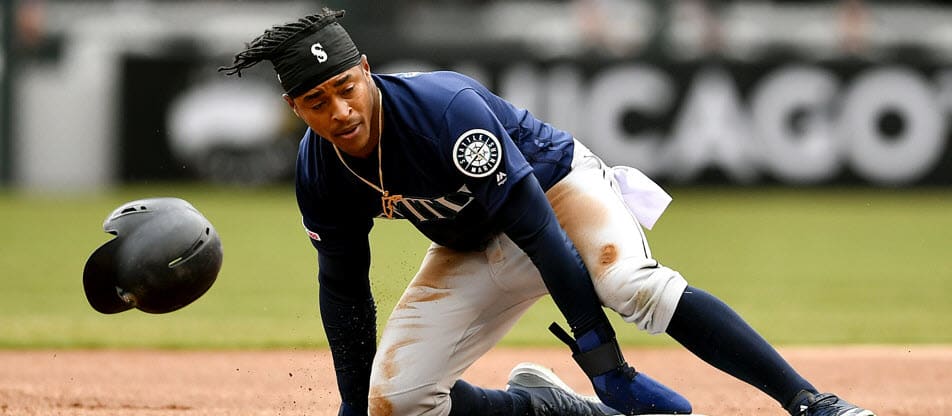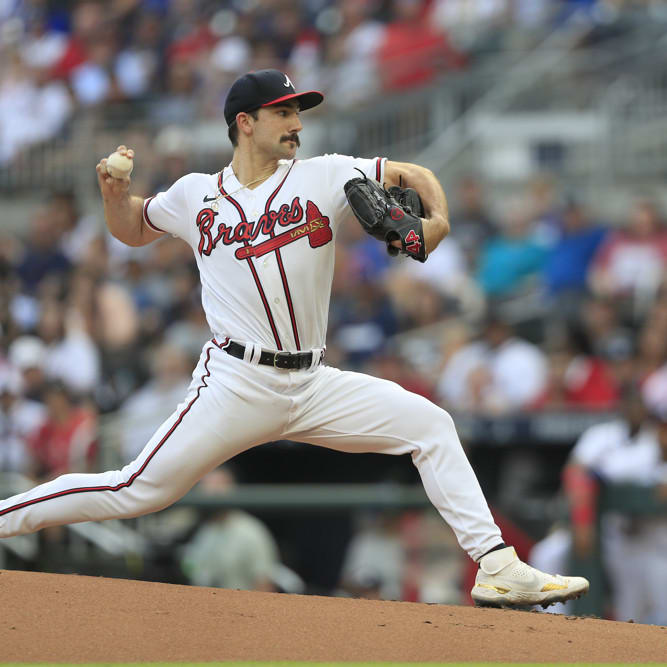This article is part of our Baseball Draft Kit series.
How many times have you discussed fantasy baseball at the end of a season and had someone tell you "I would have won my league if only this one player hadn't gotten hurt" or "I can't believe this player I drafted in the second round was awful all year -- I had no chance"?
It happens -- of course it happens. Luck is part of the game. It always will be.
But one of the goals in this silly game we play is to eliminate luck as much as possible and take control of our seasons.
A lot of this has to do with roster construction, one of the least discussed elements of fantasy baseball. We talk a lot about individual players. Some of us go on and on about projections and valuations systems -- really important (if extraordinarily geeky) things.
We don't spend a lot of time thinking about how all the pieces come together -- roster construction. The relative lack of speed and flood of power, though, hammers home why thinking about it is so important heading into 2020.
A hypothetical: are you better off drafting a player who is projected to hit 40 HR and steal zero bases and a second player who is projected to do the exact opposite and steal 40 bases and hit no dingers, or are you better off drafting two players who both project to hit 20 HR and steal 20 bases?
From a pure standings perspective the answer of course is
How many times have you discussed fantasy baseball at the end of a season and had someone tell you "I would have won my league if only this one player hadn't gotten hurt" or "I can't believe this player I drafted in the second round was awful all year -- I had no chance"?
It happens -- of course it happens. Luck is part of the game. It always will be.
But one of the goals in this silly game we play is to eliminate luck as much as possible and take control of our seasons.
A lot of this has to do with roster construction, one of the least discussed elements of fantasy baseball. We talk a lot about individual players. Some of us go on and on about projections and valuations systems -- really important (if extraordinarily geeky) things.
We don't spend a lot of time thinking about how all the pieces come together -- roster construction. The relative lack of speed and flood of power, though, hammers home why thinking about it is so important heading into 2020.
A hypothetical: are you better off drafting a player who is projected to hit 40 HR and steal zero bases and a second player who is projected to do the exact opposite and steal 40 bases and hit no dingers, or are you better off drafting two players who both project to hit 20 HR and steal 20 bases?
From a pure standings perspective the answer of course is they're both the same -- you end up with 40 projected home runs and steals in either case -- so a reasonable answer is "I'm agnostic between the two, I'll take the cheaper pair, whether in auction dollars or draft pick cost".
This is where roster construction and the concept of antifragility come into play.
Professor Nassim Nicholas Taleb introduced the concept of antifragility in his books and papers. A quick definition of antifragility (and I know some of your eyes are already glossing over, this is supposed to be about baseball, not whatever...this is. I hear ya, trust me it will be worth it):
"Some things benefit from shocks; they thrive and grow when exposed to volatility, randomness, disorder, and stressors and love adventure, risk and uncertainty. Yet, in spite of the ubiquity of the phenomenon, there is no word for the exact opposite of fragile. Let us call it antifragile. Antifragility is beyond resilience or robustness. The resilient resists shocks and stays the same; the antifragile gets better."
So what does this have to do with anything?
Think back to my hypothetical. I would argue that the team that drafts the 40-homer player and the 40-steal player has a fragile roster. What happens if either of the two players gets injured for any period of time? Well you certainly aren't finding the missing 40 stolen bases on your waiver wire. You may be able to find some power, but you are so reliant on that 40-homer guy for your home runs, you'll be short there too.
But it's fragile for more reasons than just extreme injury exposure. Let's say in mid-May you grab a hot young prospect off the waiver wire. By June they're playing out of their mind so you really want to start using them every week. Here's the problem -- unless the prospect is giving crazy speed, you need to keep playing your speed guy (because you're counting on those 40 steals), and the exact same thing applies with the power guy.
While this is obviously an extreme hypothetical, you are not in a good position to take advantage of opportunities as they arise because of the way you've constructed your roster.
The two 20-20 players, by contrast, is an antifragile roster construction. If one of the two players gets hurt for a significant part of the season, it isn't good news (injuries very rarely are). But you still have some speed, and some power. You are thus totally free and flexible to replace the injured player with a power hitter or a speedster, and you are still fine in the other category.
That's the resilience of this roster construction. But antifragility is more than just resilience -- ability to survive. It's that you get better because of volatility. A baseball projection is just the most likely outcome -- the 50th percentile.
When we say a player is projected to go 20-20, there's (let's say) a 30% chance they go 25-25. A 10% chance they go 30-30. And a 30% chance they go 15-15.
So I'd argue the odds your two 20-20 players end up giving you 50 homers and 50 steals combined is higher than the 40-homer player hitting 50 home runs, while your 40-steal guy goes off for 50 steals. I also would argue each player is a hedge against the other (i.e. one player might hit 18 homers, the other 22 leaving you in the same place. It's less likely with the other pair).
Revisiting the 'hot rookie' -- your roster is so much more flexible to take advantage of new players entering the player pool with this second pairing.
An antifragile fantasy baseball roster has two main characteristics:
1. You never want to put yourself in a position where the loss of any one player is crippling. This doesn't mean that losing your first-round pick won't hurt -- it always will -- but from a category perspective, if you've built an antifragile roster you should be able to survive the loss.
2. An antifragile roster should be structured in such a way that as the chaos of the baseball season unfolds, you are positioned to take advantage and grow stronger.
What does this have to do with the actual topic of this article, namely how to tackle speed in 2020?
A lot.
First, some context on speed. It's the most-repeated cliché in fantasy baseball over the last 12 months that power is everywhere, speed is scarcer than ever. The takeaway from the cliché that many are taking is you need to get speed early and often if you want to compete.
The numbers tell a slightly different story.
In 2019, in order to finish third in the average NFBC Main Event league in stolen bases, you needed 129 stolen bases. That's down from 140 the year before -- a big drop for one year.
But the decline in speed is nothing compared to the rise in power. To finish third in home runs last year you needed 363 homers, on average. That's up 65 homers from the 298 it took to finish third in 2018.
So here's the problem with the "you have to chase speed because it's rare" argument: the NFBC uses a standard 14 hitters. If you assume you are going to get zero stolen bases from your two catchers, you need to average 11 steals from your other 12 roster spots. That's not easy -- only 59 players got to 11 steals last year.
To get to 363 home runs though, you need to average 26 home runs over all 14 roster spots. Only three catchers got to 26 home runs last year so if you assume you get 40 homers total from those two spots, you now need to average 27 home runs from your other 12 roster spots.
Averaging 27 home runs is incredibly hard to do even when power is plentiful.
But let's say you decide "I need speed" so you go to last year's leaderboard and see that Mallex Smith led baseball with 46 steals. And let's say you decide that he's going to do it again, so you target Mallex Smith.
Here's the problem with that: instead of 27 home runs, you now need to average almost 30 home runs from every other non-catcher spot on your roster. You still need more than 80 stolen bases too to hit that 129-steal target from last year. While getting 30 home runs from every player.
I would argue that because of the elevated home-run total, it is almost impossible to roster any player who hits less than 10 home runs in anything other than deep, AL- or NL-only leagues and it is hard to roster players who won't hit 15.
But the argument against drafting the Mallex Smiths of the world goes even deeper than that -- it comes back to building an antifragile roster. If you draft Smith and he gets hurt. Or he gets benched (like Dee Gordon and Billy Hamilton did last year). Or he just doesn't run much this year, you are instantly uncompetitive in steals. One player has crippled you in that category. Tough to bench him, since he is your speed. Impossible to replace what you thought you were drafting off waivers.
So we find ourselves in a bit of a conundrum: we need speed to compete.
Speed is scarce. But paying a premium for speed? It's a bit of a trap that may result in you being short power (and I haven't even discussed runs and RBI, the underrated categories) and over-reliant on one or two guys.
So my advice is to build an antifragile roster that is not reliant on one player for speed, that can take advantage of breakouts and emerging players and that doesn't cripple you in the other offensive categories because you've chased elusive rabbits.
Or just draft Ronald Acuna Jr. -- that's also a good strategy. But if you can't do that, go antifragile.
This article appears in the 2020 RotoWire Fantasy Baseball Guide. You can order a copy here.










